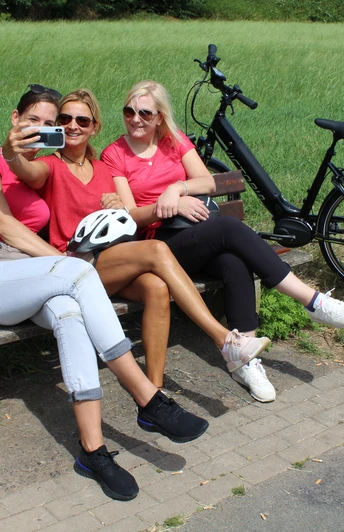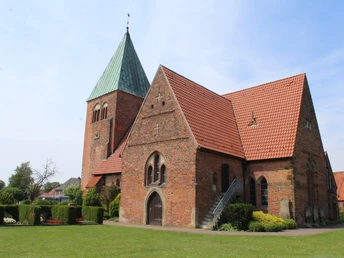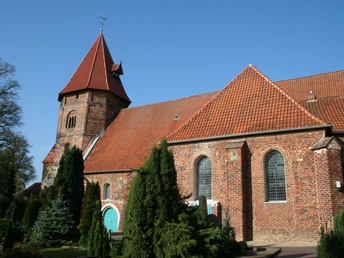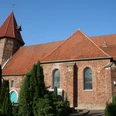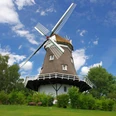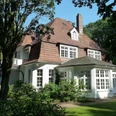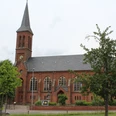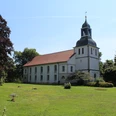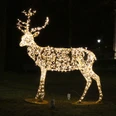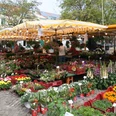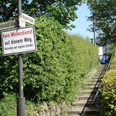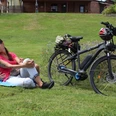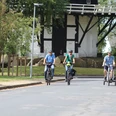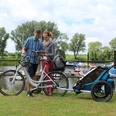- 3:47 h
- 59.52 km
- 61 m
- 64 m
- 5 m
- 38 m
- 33 m
- Start: Achim
- Destination: Achim
Open churches:
Church towers are landmarks, especially in a landscape as vast as the Wesermarsch. They bear witness not only to the architecture of past generations, but also to the Christian faith. It is astonishing in what a variety of ways this faith has found expression in our churches: from the Romanesque period to the architecture of the 1960s.
You are invited to go on a journey of discovery in this region, the recreational landscape between the Weser and the heath, with its special cultural and historical features. Take a break from everyday life and enjoy this fascinating expanse of earth and sky. Let the church towers, visible from afar, invite you not only to visit them, but also to enjoy silence, devotion or prayer.
Route description (circular route):
Start your cycle tour in Achim. You can also start this circular route in any other town along the route. You will find parking spaces in all towns along the cycle route. In the center of the "farmers' quarter", the origin of today's town of Achim, stands the St. Laurentius church, built in the 12th century, on a geest ridge above the Weser, with a rich interior. From there, take a detour through the town center to the Catholic church in Meislahnstraße. Then return to the starting point and pass the "Clüverhaus" (two-storey house), among other things. It is well worth a visit. Passing the Achim windmill, you reach the Weser bridge, cross the river and the Weser marshes lie before you. Through the marsh pastures you reach the Eyterschöpfwerk near Eißel.
You continue through perhaps the most beautiful section of the Wesermarsch: ancient hawthorn hedges characterize the landscape and provide a habitat for many animals. A detour to the south takes you to "Gut Oenigstedt" with its beautiful half-timbered houses. You then reach Riede. At the center of the village is the 700-year-old church with its unique ceiling paintings of biblical motifs from the late Middle Ages. Via Donnerstedt, also known as the place of orchards, you cycle along the "Adeligen Holz", a small remnant of a once extensive wooded area. Your destination is now Thedinghausen.
The origins of the church have a special connection: the Archbishop of Bremen, Johann Friedrich, had today's hereditary farm (on the road to Lunsen) built for his mistress in 1620. But the Lunsen pastor - the only one in this area! - railed against the decline in morals. In order to spare himself and his mistress his sermons, the bishop had a pastor appointed in Thedinghausen who he liked. This was the decisive step towards the creation of an independent parish. The present church building was erected in 1870 in the style of the time. You should also take a look at the "Poggenburg" estate, today the seat of the joint municipal administration.
And another special feature about Thedinghausen: from 1679 to 1972, the "Amt Thedinghausen" belonged to Braunschweig. Your route now takes you past the aforementioned Erbhof farm to Lunsen, whose church tower is the most impressive in the entire Wesermarsch region. For a long time, Lunsen was a parish for the surrounding communities, hence this mighty church. Via Beppen, situated on the edge of a marshland, you come to Gahlstorf, where the "Gahlstorfer Ring", a gold ring once imported from Ireland, was found. In Blender, the church, which was added to the older tower by master church builder Hellner in 1827, will show you its new splendor. You should pay attention to the gravestone between the tower hall and the nave: it commemorates the first Protestant pastor Bertram Karbuch, who was killed by the sexton's son. The church housed a Furtwängler organ from 1852.
Take a short detour to the Blender windmill on the Verden - Thedinghausen road, which is well worth seeing. Along Lake Blender, between the "Kuhlen" (both remnants of an old arm of the Weser), you reach the southernmost point of this circular route: Oiste with the smallest church far and wide. Hard to believe: it was the seat of the regional superintendent until the end of the 1960s. Via Amedorf and Reer you come to Intschede. Today's church, built in 1819 in the classical style, is idyllically situated next to a half-timbered granary worth seeing.
Above the Weser weir with its run-of-river power station and the lock canal bridge, you come to Daverden, whose church you can see from afar, situated on a geest ridge. From there you have a sweeping view over the Wesermarsch. The interior of this church, which was begun in the 12th century, with its rare cruciform floor plan, is well worth seeing. Some parts of the organ go back to the famous master Arp Schnitger.
Cross the wooded Geestrücken ridge through Cluvenhagen to Etelsen. Here you will find the newest church on the Church Cycle Route, the Church of the Good Shepherd, consecrated in 1962. The "Good Shepherd" is a statue on the church spire. Now it's a little way downhill, past the Jan Wind windmill to Etelsen Castle with its beautiful park. It is worth making a longer stop here. Hidden in the park is a neo-Gothic mausoleum, which is now used for art.
The route then follows the course of the Weser again. You now reach Baden, the only district of Achim with its own church. This simple building was created in the 1950s from a cemetery chapel after Baden had grown so large that it became an independent parish. Parallel to the Weser, past the "Hünenburg", a 12th century hill fort, you return to Achim, the starting point of this circular route.
You can also find the church cycle route at Komoot.
Safety information:
Church towers are landmarks, especially in a landscape as vast as the Wesermarsch. They bear witness not only to the architecture of past generations, but also to the Christian faith. It is astonishing in what a variety of ways this faith has found expression in our churches: from the Romanesque period to the architecture of the 1960s.
You are invited to go on a journey of discovery in this region, the recreational landscape between the Weser and the heath, with its special cultural and historical features. Take a break from everyday life and enjoy this fascinating expanse of earth and sky. Let the church towers, visible from afar, invite you not only to visit them, but also to enjoy silence, devotion or prayer.
Route description (circular route):
Start your cycle tour in Achim. You can also start this circular route in any other town along the route. You will find parking spaces in all towns along the cycle route. In the center of the "farmers' quarter", the origin of today's town of Achim, stands the St. Laurentius church, built in the 12th century, on a geest ridge above the Weser, with a rich interior. From there, take a detour through the town center to the Catholic church in Meislahnstraße. Then return to the starting point and pass the "Clüverhaus" (two-storey house), among other things. It is well worth a visit. Passing the Achim windmill, you reach the Weser bridge, cross the river and the Weser marshes lie before you. Through the marsh pastures you reach the Eyterschöpfwerk near Eißel.
You continue through perhaps the most beautiful section of the Wesermarsch: ancient hawthorn hedges characterize the landscape and provide a habitat for many animals. A detour to the south takes you to "Gut Oenigstedt" with its beautiful half-timbered houses. You then reach Riede. At the center of the village is the 700-year-old church with its unique ceiling paintings of biblical motifs from the late Middle Ages. Via Donnerstedt, also known as the place of orchards, you cycle along the "Adeligen Holz", a small remnant of a once extensive wooded area. Your destination is now Thedinghausen.
The origins of the church have a special connection: the Archbishop of Bremen, Johann Friedrich, had today's hereditary farm (on the road to Lunsen) built for his mistress in 1620. But the Lunsen pastor - the only one in this area! - railed against the decline in morals. In order to spare himself and his mistress his sermons, the bishop had a pastor appointed in Thedinghausen who he liked. This was the decisive step towards the creation of an independent parish. The present church building was erected in 1870 in the style of the time. You should also take a look at the "Poggenburg" estate, today the seat of the joint municipal administration.
And another special feature about Thedinghausen: from 1679 to 1972, the "Amt Thedinghausen" belonged to Braunschweig. Your route now takes you past the aforementioned Erbhof farm to Lunsen, whose church tower is the most impressive in the entire Wesermarsch region. For a long time, Lunsen was a parish for the surrounding communities, hence this mighty church. Via Beppen, situated on the edge of a marshland, you come to Gahlstorf, where the "Gahlstorfer Ring", a gold ring once imported from Ireland, was found. In Blender, the church, which was added to the older tower by master church builder Hellner in 1827, will show you its new splendor. You should pay attention to the gravestone between the tower hall and the nave: it commemorates the first Protestant pastor Bertram Karbuch, who was killed by the sexton's son. The church housed a Furtwängler organ from 1852.
Take a short detour to the Blender windmill on the Verden - Thedinghausen road, which is well worth seeing. Along Lake Blender, between the "Kuhlen" (both remnants of an old arm of the Weser), you reach the southernmost point of this circular route: Oiste with the smallest church far and wide. Hard to believe: it was the seat of the regional superintendent until the end of the 1960s. Via Amedorf and Reer you come to Intschede. Today's church, built in 1819 in the classical style, is idyllically situated next to a half-timbered granary worth seeing.
Above the Weser weir with its run-of-river power station and the lock canal bridge, you come to Daverden, whose church you can see from afar, situated on a geest ridge. From there you have a sweeping view over the Wesermarsch. The interior of this church, which was begun in the 12th century, with its rare cruciform floor plan, is well worth seeing. Some parts of the organ go back to the famous master Arp Schnitger.
Cross the wooded Geestrücken ridge through Cluvenhagen to Etelsen. Here you will find the newest church on the Church Cycle Route, the Church of the Good Shepherd, consecrated in 1962. The "Good Shepherd" is a statue on the church spire. Now it's a little way downhill, past the Jan Wind windmill to Etelsen Castle with its beautiful park. It is worth making a longer stop here. Hidden in the park is a neo-Gothic mausoleum, which is now used for art.
The route then follows the course of the Weser again. You now reach Baden, the only district of Achim with its own church. This simple building was created in the 1950s from a cemetery chapel after Baden had grown so large that it became an independent parish. Parallel to the Weser, past the "Hünenburg", a 12th century hill fort, you return to Achim, the starting point of this circular route.
You can also find the church cycle route at Komoot.
Safety information:
- Throughout the entire tour, please note that the cycle paths are used at your own risk
- No guarantee is given for the usability of the cycle paths
- In cities, increased attention is generally required
- Please use existing cycle paths
- Dangerous spots must be expected on the tour, such as bollards, barriers to traffic
- .bollards, barriers and unsecured crossings of main roads - this advice applies in particular to cycling families with small children.
Good to know
Best to visit
suitable
Depends on weather
Author
Mittelweser-Touristik GmbH
Lange Straße 18
31582 Nienburg/Weser
Organization
Mittelweser-Touristik GmbH
License (master data)
Mittelweser-Touristik GmbH
Our recommendations
Nearby
